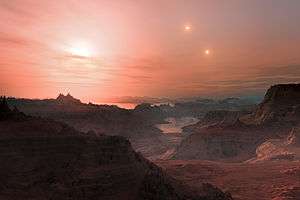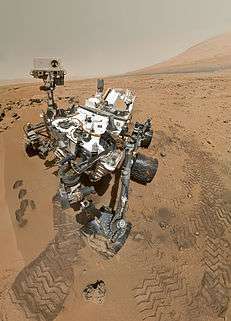HD 40307 f
| Exoplanet | List of exoplanets | |
|---|---|---|
| Parent star | ||
| Star | HD 40307 | |
| Constellation | Pictor | |
| Right ascension | (α) | 05h 54m 04.2409s[1] |
| Declination | (δ) | −60° 01′ 24.498″[1] |
| Apparent magnitude | (mV) | 7.17[1] |
| Distance | 41.8 ± 0.3 ly (12.83 ± 0.09[1] pc) | |
| Spectral type | K2.5V[1] | |
| Radius | (r) | 0.716 ± 0.010[2] R☉ |
| Temperature | (T) | 4977 ± 59[3] K |
| Metallicity | [Fe/H] | −0.31 ± 0.03[3] |
| Age | 1.2 (≥ 0.2)[4] Gyr | |
| Orbital elements | ||
| Semi-major axis | (a) | 0.247 [0.233, 0.258][5] AU |
| Eccentricity | (e) | 0.03 [0, 0.13][5] |
| Orbital period | (P) | 51.76 [51.30, 52.26][5] d |
| Semi-amplitude | (K) | 1.09 [0.77, 1.37][5] m/s |
| Physical characteristics | ||
| Minimum mass | (m sin i) | 5.2 [3.6, 6.7][5] M⊕ |
| Discovery information | ||
| Discovery date | October 28, 2012 | |
| Discoverer(s) | Mikko Tuomi et al. | |
| Discovery method | radial velocity, using HARPS | |
| Discovery site | La Silla Observatory, Chile | |
| Discovery status | Announced[5] | |
| Database references | ||
| Extrasolar Planets Encyclopaedia | data | |
| SIMBAD | data | |
| Exoplanet Archive | data | |
| Open Exoplanet Catalogue | data | |
HD 40307 f is an extrasolar planet orbiting the star HD 40307. It is located 42 light-years away in the direction of the southern constellation Pictor. The planet was discovered by the radial velocity method, using the European Southern Obervatory's HARPS apparatus[5][6][7] by a team of astronomers led by Mikko Tuomi at the University of Hertfordshire and Guillem Anglada-Escude of the University of Goettingen, Germany.[8]
This planet is the fifth planet from the star, at a distance of about 0.25 AU (compared to 0.39 AU for Mercury) with negligible eccentricity.
HD 40307 f's minimum mass is 5.2 that of Earth, and dynamical models suggest it cannot be much more (and so is measured close to edge-on).[5] Planets like this in that system have been presumed "super-Earth".[3]
Even though HD 40307 f is closer to the star than Mercury is to the Sun,[9] it gets (slightly) less insolation than Mercury gets because the parent star is dimmer than our home star.[10] It still gets more heat than Venus gets (like Gliese 581 c), and it has more gravitational potential than Venus has. HD 40307 f is more likely a super-Venus than a "super-Earth".[11]
Moreover, planets b, c, and d are presumed to have migrated in from outer orbits; and planet b is predicted a sub-Neptune.[12] It is likely that this planet f formed even further out. Whether it is a sub-Neptune or super-Venus is, perhaps, a moot point.
References
- 1 2 3 4 5 "HD 40307". SIMBAD. Centre de Données astronomiques de Strasbourg. 2008. Retrieved 18 June 2008.
- ↑ HD 40307, entry, CDS database J/A+A/450/735; described in Effective temperature scale and bolometric corrections from 2MASS photometry, E. Masana, C. Jordi, and I. Ribas, Astronomy and Astrophysics 450, #2 (May 2006), pp. 735–746. Bibcode: 2006A&A...450..735M. doi:10.1051/0004-6361:20054021.
- 1 2 3 M. Mayor; S. Udry; C. Lovis; F. Pepe; D. Queloz; W. Benz; J.-L. Bertaux; F. Bouchy; C. Mordasini; D. Segransan (2009). "The HARPS search for southern extra-solar planets. XIII. A planetary system with 3 Super-Earths (4.2, 6.9, & 9.2 Earth masses)". Astronomy and Astrophysics. 493 (2): 639–644. arXiv:0806.4587
 . Bibcode:2009A&A...493..639M. doi:10.1051/0004-6361:200810451.
. Bibcode:2009A&A...493..639M. doi:10.1051/0004-6361:200810451. - ↑ HD 40307, database entry, Geneva-Copenhagen Survey of Solar neighbourhood, J. Holmberg et al., 2007, CDS database V/117A, accessed November 19, 2008; described in The Geneva-Copenhagen survey of the Solar neighbourhood. Ages, metallicities, and kinematic properties of ~14 000 F and G dwarfs, B. Nordström, M. Mayor, J. Andersen, J. Holmberg, F. Pont, B. R. Jørgensen, E. H. Olsen, S. Udry, and N. Mowlavi, Astronomy and Astrophysics 418 (May 2004), pp. 989–1019, Bibcode: 2004A&A...418..989N, doi:10.1051/0004-6361:20035959.
- 1 2 3 4 5 6 7 8 Tuomi, Mikko; Anglada-Escude, Guillem; Gerlach, Enrico; Jones, Hugh R. R.; Reiners, Ansgar; Rivera, Eugenio J.; Vogt, Steven S.; Butler, R. Paul (2012). "Habitable-zone super-Earth candidate in a six-planet system around the K2.5V star HD 40307". arXiv:1211.1617v1
 [astro-ph].
[astro-ph]. - ↑ Wall, Mike (November 7, 2012). "'Super-Earth' Alien Planet May Be Habitable for Life". Space.com. Retrieved November 8, 2012.
- ↑ Tate, Karl (November 7, 2012). "Super-Earth Planet: Potentially Habitable Alien World Explained (Infographic)". Space.com. Retrieved November 8, 2012.
- ↑ Murrin, Marc (November 8, 2012). "Astronomers discover a potentially habitable Super-Earth HD 40307g (Infographic)". tech-stew.com. Retrieved November 8, 2012.
- ↑ "Mercury Fact Sheet". NASA Goddard Space Flight Center. November 17, 2010. Retrieved 2012-11-10.
- ↑ Tuomi, Fig 17
- ↑ Tuomi, Fig 17 cites Fig 4 in F. Selsis; et al. (2007). "Habitable planets around the star Gl 581?". Astronomy & Astrophysics. 476: 1373. arXiv:0710.5294
 . Bibcode:2007A&A...476.1373S. doi:10.1051/0004-6361:20078091., "100% clouds" region
. Bibcode:2007A&A...476.1373S. doi:10.1051/0004-6361:20078091., "100% clouds" region - ↑ Barnes, R.; Jackson, B.; Raymond, S.; West, A.; Greenberg, R. (2009). "The HD 40307 Planetary System: Super-Earths or Mini-Neptunes?". The Astrophysical Journal. 695 (2): 1006. arXiv:0901.1698
 . Bibcode:2009ApJ...695.1006B. doi:10.1088/0004-637X/695/2/1006.
. Bibcode:2009ApJ...695.1006B. doi:10.1088/0004-637X/695/2/1006.
External links
- "Super-Earth Discovered in Star's Habitable Zone". Exoplanets.
Coordinates: ![]() 05h 54m 04.2409s, −60° 01′ 24.498″
05h 54m 04.2409s, −60° 01′ 24.498″

